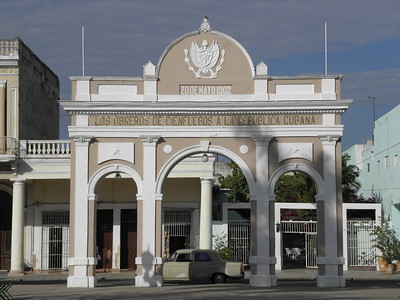Cienfuegos

The Urban Historic Centre of Cienfuegos is the best extant example of 19th-century urban planning principles in Latin America.
The homogenous architecture and streetplan of this seaport was influenced by the Spanish Enlightenment and French colonists. New ideas of modernity, hygiene and order were implemented here, and the the streets are of a neo-classic straight and symmetric design, with the use of porches and arcades.
Community Perspective: “the most elegant and prosperous Cuban city”. Visit the Parque José Marti, the central square surrounded by monumental buildings, and the Teatro Tomas Terry.
Map of Cienfuegos
Load mapCommunity Reviews
Alexander Barabanov

Visited this site in May 2018.
Our visit was slightly shortened by the car breaking, but with some luck, we found local mechanic, who fixed everything in 10 minutes.
The elegant core of the city is concentrated around main square – Parque Jose Marti. The architecture was inspired by the founders – French emigrants. The city is not that old, it was only founded in 1819 and was influenced by the neoclassic ideas of the settlers. The key attractions are Teatro Tomas Terry (1889) with good external mosaics, Arco de Triunfo (1902), Catedral de la Purisima Concepcion Church (1869), Palacio de Gobierno (1917) and Casa de la Cultura Benjamin Duarte or Palacio de Ferrer (1918). For 1 cuc we climbed the latter one, with dominating light blue cupola and iron staircase. There good views over the city, with some usual for Cuba a bit dilapidating impression. Despite the buildings constructed in various periods, together they create quite balanced and harmonic ensemble. We also made a stroll along key shopping and pedestrian street El Bulevar.
We liked Cienfuegos, as it is not usual colonial town, but a later example of neoclassical architecture.
Els Slots

Cienfuegos is the most elegant and prosperous Cuban city that I visited on my trip. Especially its Punta Gorda neighbourhood – palm trees everywhere, wide streets, comfortable-looking houses, a marina. It could be Florida. A very pleasant place to wander about. I also used the city buses, which by western standards are so incredibly cheap that I even wasn’t able to change money so small. My casa owner ended up just giving me some coins. A ride costs 20 centavos in Moneda Nacional, that’s about 0,007 EUR.
The WHS area comprises the historic centre, and then mainly the Parque José Marti, the central square. It has monumental buildings on all sides. These include the iconic City Hall (former Governal Palace and now home to the regional administration), which unfortunately you cannot enter. Next to it is the Provincial Museum, worth a look for its quirkiness but like most museums in Cuba not with a strong collection or presentation. There’s the cathedral, undergoing restorations at the moment and looking much like a construction site. The fine blue turret of the Palacio de Ferrer. The center of the square holds the obligate statues and the quite small Worker’s Arch (a triumphal arch) and a bandshell.
The best sight here undoubtedly is the Teatro Tomas Terry, located on the north side of the square. It opened in 1895. From the outside, it is just one of those big neoclassical buildings that Cienfuegos has in abundance. Its interior is so lovely however. Together with Matanzas' old pharmacy, I think this is the best individual historic monument in Cuba. It has great period furnishings, like lamps, cast-iron grills, a painted ceiling, and folding seats.
Cena
The Urban Historic Centre of Cienfuegos is amazing. The buildings are all being repaired and restored after the hurricane last year. One of my favorite places down there is the Tomas Terry cafe, which has musical groups performing almost nightly. Although, this place is geared more for tourists than some of the other places in Cienfuegos. On Thursday nights there is a Rumba performance for tourists to experience here as well. Also, there are day activities all the time throughout Cienfuegos. You can ask what is going on where and when at the House of Culture, which is also in this square.
You can definitely see the French influence in this square (Parque Jose Marti). I recommend that you take a walk down the streets leading out of this square and explore the city. While it is a positive thing that the facades of buildings are being restored, I think it is important to also focus on the restoration of the inside of buildings. There are so many houses a few streets over, on the Prado, that are historically important, architecturally, that need to be restored and preserved as well.
I was not a tourist in Cienfuegos, I was a student. Because of this, I was able to explore a lot of the city. I would recommend seeing more than just this square but this part of town is definitely worth seeing.
Community Rating
- : Sofia SJM Deffra Rahelka
- : Anne
- : PabloNorte SaoDies CascadianRain Kent Alejandro Lau
- : Jon Eshuijs Svein Elias DeanS Philipp Leu ChrisN
- : Ivan Rucek Eric PK Alexander Barabanov Alexander Parsons Lukasz Palczewski Michael anak Kenyalang George Gdanski Ludvan Aidan Coohill Hanming GerhardM Emily Cullen Csaba Nováczky
- : Els Slots Solivagant Joyce van Soest Roman Raab Martina Rúčková Craig Harder Randi Thomsen Stanislaw Warwas Zizmondka MH
- : Dimitrios Polychronopoulos Riccardo Quaranta Jean Lecaillon Ammon Watkins Mazeman
- : Zoë Sheng Lembu
- : Joaofg
Site Info
Site History
2005 Inscribed
Site Links
Unesco Website
Connections
The site has 17 connections
Art and Architecture
Constructions
Damaged
Geography
History
Human Activity
Religion and Belief
Timeline
Trivia
WHS Names
WHS on Other Lists
World Heritage Process
Visitors
209 Community Members have visited.
The Plaque
 (external source)
(external source)